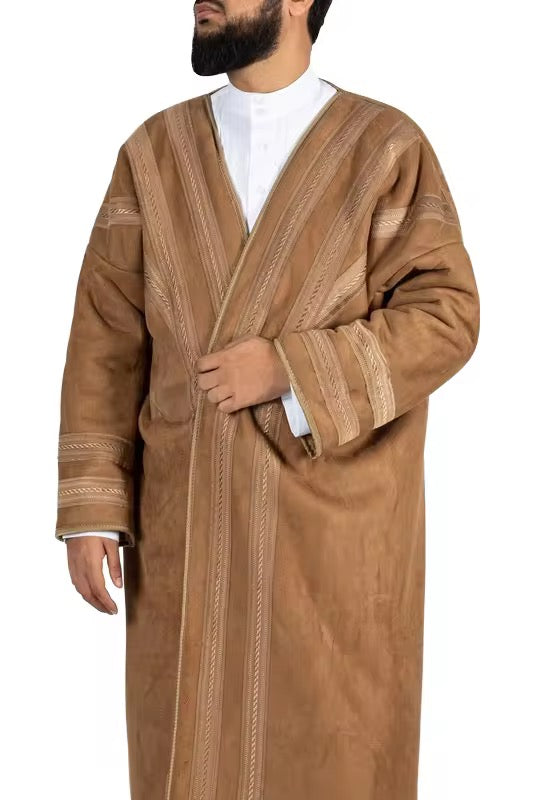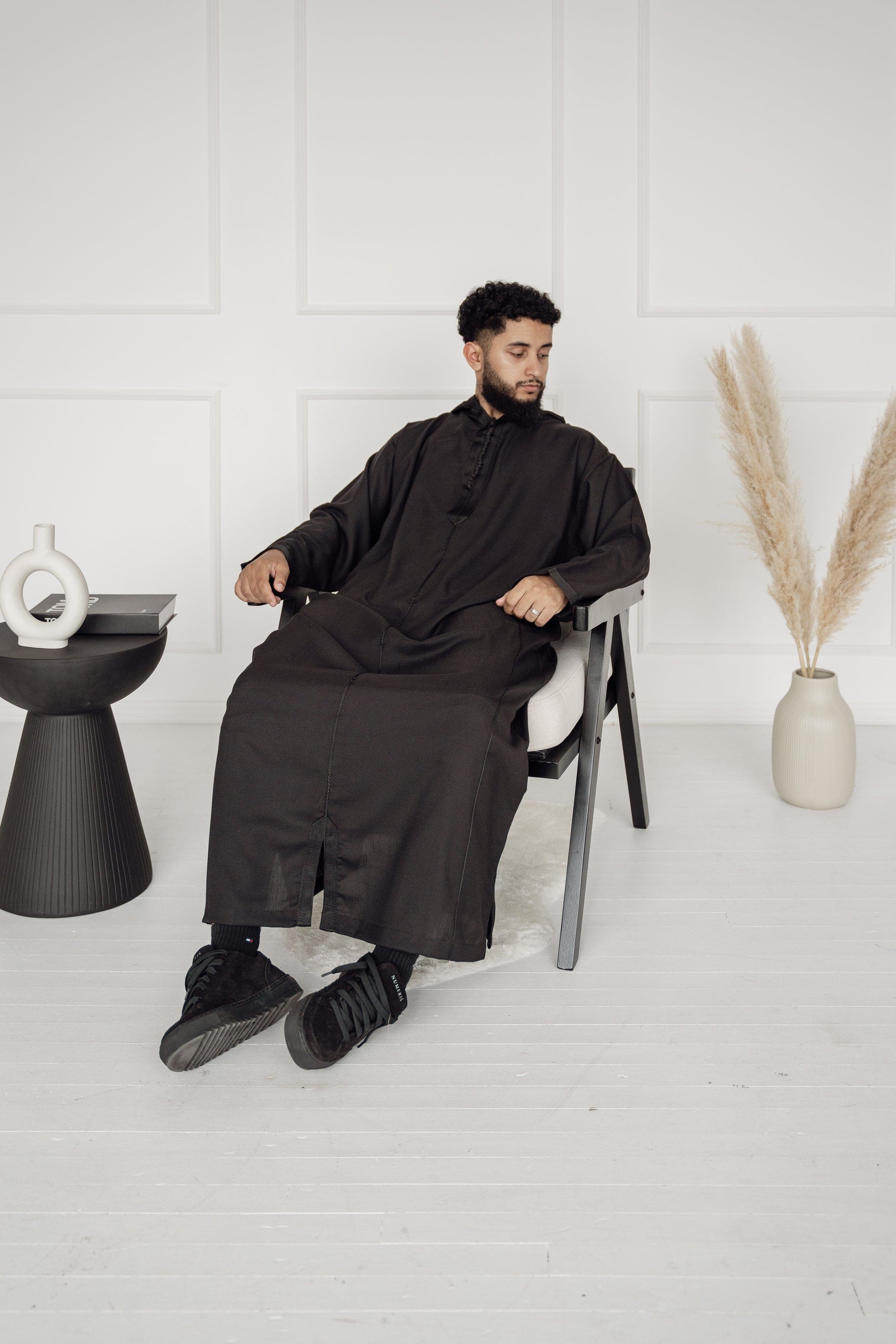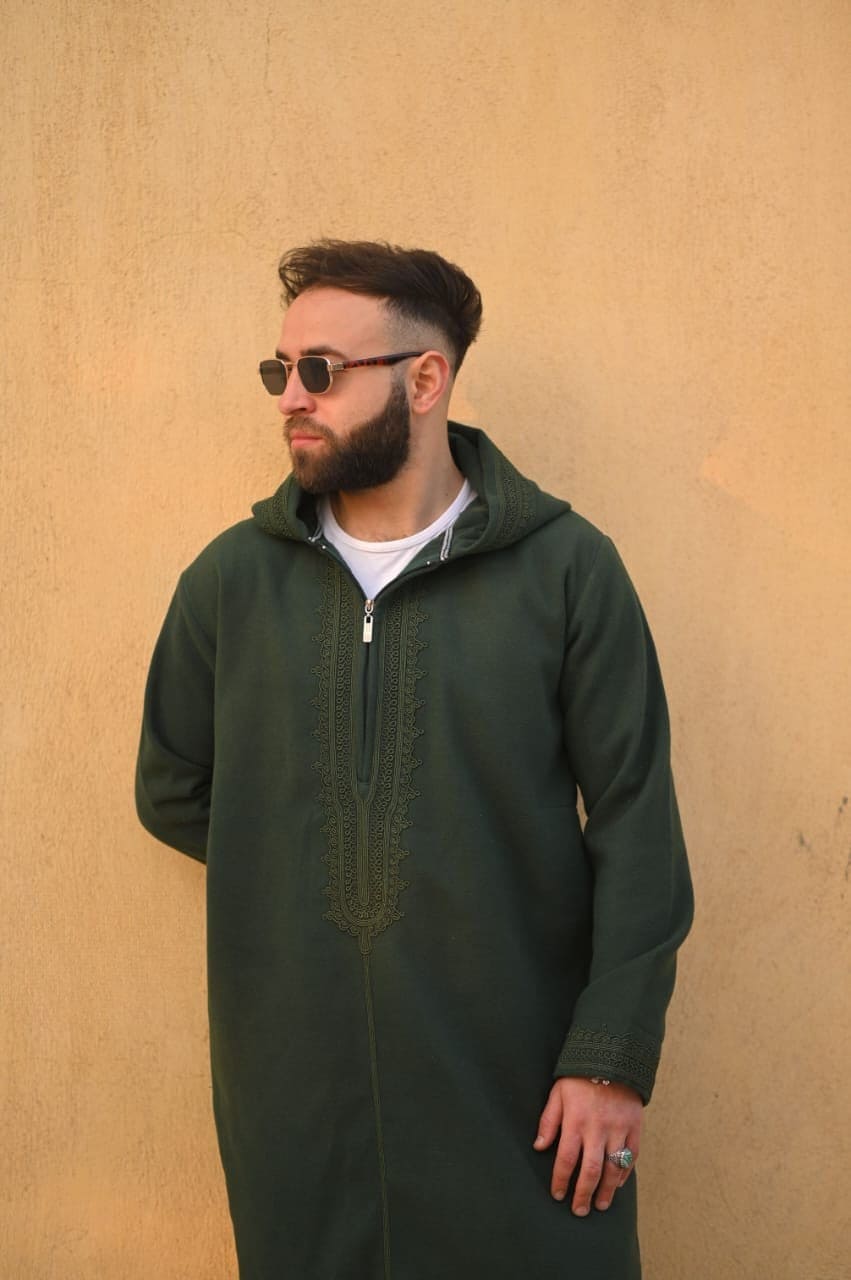What Actually is a Farwa?
If you've never heard of a farwa (pronounced "FAR-wah" in Arabic, فروة), you're not alone - but that's changing fast. This traditional Arabian winter coat, also known as a bisht (pronounced "BISHT," بشت) in some Gulf regions, has been keeping people warm across the Middle East for centuries, and it's now making serious waves in the UK fashion scene for 2025 and 2026.
Picture this: an oversized, cozy coat originally made from lambskin and wool, designed by Bedouin communities who knew a thing or two about surviving extreme desert temperatures. Yes, deserts get absolutely freezing at night - and the farwa was their answer to staying warm when temperatures plummeted.
These days, you'll see farwas everywhere from Riyadh to Dubai, worn by everyone from grandparents to teenagers. It's no longer just an "old person's coat" - it's become something of a style statement. And now, British Muslims especially are catching on as Khaleeji fashion becomes increasingly trendy and fashionable in the UK. What started as traditional religious wear is now crossing over into everyday style-conscious choices.
The Surprising History Behind the Farwa
Desert Nights Get Cold. Really Cold.
Here's what most people don't realize about deserts: they're not just hot. When the sun goes down, temperatures can drop dramatically, sometimes hitting near-freezing. The Bedouin people figured this out centuries ago and created the farwa as their solution.
They used young lambskin - typically from lambs no older than two months - because it provided the best insulation. The wool stayed attached to the skin, creating a natural barrier against the cold that nothing else could match.
Interestingly, "farwa" in Arabic is associated with blessings and prosperity. Makes sense when you think about how valuable a warm coat would be in the harsh desert environment.
How Did We Get Here?
For a long time, farwas were pretty much the domain of older men. You'd rarely see young people wearing them - they were seen as traditional, maybe a bit old-fashioned.
But something shifted in the last decade or so. Young people across Syria, Saudi Arabia, and the broader Gulf region started embracing the farwa again. Maybe it's the global interest in heritage fashion, maybe it's just that people realized how incredibly warm these coats are. Either way, the farwa is having a proper moment.
The UK Fashion Shift: From Morocco to the Gulf
Here's what's happening in British modest fashion right now: there's a massive shift from Moroccan styles to Khaleeji (Gulf) fashion. The Moroccan djellaba had its moment - and don't get me wrong, they're still lovely - but the trend is moving on.
Summer Moroccan thobes? They've had their time in the spotlight. Now, it's all about the more business-oriented, luxury thobes coming out of Saudi Arabia and the Gulf. Think sharper cuts, premium fabrics, sophisticated styling. And for winter? The farwa is stepping in as the natural cold-weather companion.
2025 and 2026 are shaping up to be the years Khaleeji winter clothing really takes off in the UK. And there's a practical reason beyond just fashion: Ramadan 2026 falls in February - right in the depths of winter. People are already thinking ahead about what they'll wear for taraweeh prayers and iftar gatherings when it's properly cold outside. A farwa over a smart thobe? Perfect solution.
Different Types of Farwa (And Why It Matters)
The Real Deal: Traditional Lambskin
Authentic farwas are made from actual lambskin with the wool still attached. The quality depends on a few things:
The youngest lambs (called "Sakhlah" and "Fatimah" in some regions) produce the softest, most luxurious wool. These are your premium farwas - the ones that'll cost you a bit more but feel absolutely incredible.
Then there's what's called "Kabashi" farwa, made from older sheep. Still warm, still traditional, just a different feel and price point.
Modern Takes on an Old Classic
Not everyone wants lambskin, and that's fine. The farwa has evolved quite a bit:
Velvet versions have become really popular, especially with younger buyers who want the look without the hefty price tag. You can get a decent velvet farwa for around £40-80.
Synthetic leather options offer better durability and are easier to look after. No special cleaning required.
High-end versions use imported fabrics - there's something called "Harbed" English fabric that's apparently exceptional, though it'll set you back a few hundred pounds.
Colors and Modern Design
Beyond Basic Black
Traditional farwas were almost always black. Full stop. But walk through any market in the Gulf today and you'll see a rainbow of options:
Browns and earth tones are classics that work with everything. Navy blue has become surprisingly popular. And then you've got the statement pieces - silver, gold, even burgundy.
Some modern farwas feature golden embroidery or traditional patterns worked into the fabric. Others keep it minimal and sleek, letting the quality of the material speak for itself.
The Pocketless Design
Here's an interesting detail about farwa bishts: they come in various practical configurations. Some modern versions feature two side pockets with faux fur lining inside, while traditional styles maintain a pocketless design. The pocketless versions create beautiful, clean lines and an uninterrupted drape that you just don't get with bulky pockets sewn in.
Plus, let's be honest, when you're wearing something this oversized, you're probably wearing layers underneath with their own pockets anyway.
Hood, Zipper, or Neither?
Modern farwa bishts offer different closure and coverage options - some come with both zippers and hoods, others feature a more traditional open-front design. The hooded versions are particularly practical for British weather, offering extra protection during those cold walks to the mosque or winter events.
Zippered styles make it easier to adjust your warmth level throughout the day, while traditional open-front designs maintain that classic, flowing silhouette that's been worn for centuries. There's even vest-style farwas for those who want the warmth without full sleeves.
Really, it comes down to personal preference and how you plan to wear it. Need maximum weather protection? Go for hood and zipper. Want traditional elegance? Stick with the classic open design.
Why Would You Actually Want a Farwa?
It's Properly Warm
Look, I could wax poetic about heritage and tradition, but let's start with the basics: farwas are incredibly warm. The combination of wool insulation and protective outer layer creates something that keeps you toasty without making you overheat.
If you've ever worn a good quality sheepskin coat, you know what I'm talking about. Now imagine that, but sized to wear over everything else you're already wearing.
Surprisingly Versatile
The oversized cut means you can throw a farwa over pretty much anything:
- Traditional thobes and dishdashas, obviously
- Jeans and a jumper for casual winter days
- Even over suits if you're heading somewhere formal in cold weather
There's Something About Wearing History
This might sound a bit romantic, but there's genuinely something special about wearing a garment with centuries of history behind it. Every farwa connects you to those Bedouin communities who perfected this design through generations of desert living.
How to Pick a Good Farwa
Think About Where You'll Wear It
British winters aren't exactly Saudi winters, but they're cold enough to appreciate a proper warm coat. Consider:
- Will you mainly wear it outdoors or in draughty buildings?
- Do you run cold or warm generally?
- Are you looking for occasional wear or everyday use?
Quality Check
When you're shopping (whether online or in person), look for:
Stitching that's even and secure - no loose threads or wonky seams. The lining should be properly attached, not just tacked on at a few points. Check the fit across the shoulders - you want room to move comfortably, but not so much that it looks like you're drowning in fabric.
If you're considering a zippered version, test the zipper quality - it should glide smoothly without catching. For hooded styles, check that the hood sits properly and doesn't pull awkwardly on the shoulders.
For lambskin versions, the wool should feel soft and dense, not patchy or thin. If it has pockets, make sure they're deep enough to actually be useful and that the fur lining inside feels secure.
What You'll Pay
Prices are all over the place depending on what you're after:
Budget synthetic options start around £50. Decent quality velvet or mixed fabrics run £50-150. Proper lambskin with traditional construction? You're looking at £150-300. Custom luxury pieces can go well over £500.
You get what you pay for, but there are good options at every price point.
Looking After Your Farwa
Cleaning Without Destroying It
Traditional lambskin farwas really need professional dry cleaning. The natural materials and construction don't take kindly to home washing experiments.
For synthetic versions, you can usually get away with careful hand washing in cold water. Just avoid anything harsh - no bleach, no hot water, no aggressive detergents. And definitely don't stick it in a hot dryer unless you fancy a shrunken, misshapen coat.
Storage That Makes Sense
Hang it on a proper padded hanger - wire ones will leave dents in the shoulders. Keep it somewhere cool and dry, away from direct sunlight which can fade the color and damage natural materials.
If you're storing it long-term (say, over summer), let it air out properly first, then use a breathable garment bag. For wool versions, chuck in some cedar or lavender to keep moths away naturally.
The Craft Behind the Coat
Traditional Craftsmanship Lives On
Making farwas the traditional way is skilled work, passed down through families over generations. The craft requires expertise in working with natural materials, understanding wool characteristics, and mastering traditional construction techniques that have remained largely unchanged for centuries.
Today, traditional farwa craftsmanship continues across the Gulf region, with artisans maintaining the quality and authenticity that makes these garments special. The focus remains on premium materials, careful construction, and attention to detail that mass production simply can't replicate.
Finding an Authentic Farwa in the UK
Why newarabia?
If you're in Britain and want a proper farwa, your options are pretty limited. That's where newarabia comes in - bringing authentic farwa bishts to the UK market.
They've done the legwork of sourcing quality pieces that honor traditional craftsmanship while working for British customers and British winters. Multiple colors, proper construction, reasonable prices.
What to Watch For
Whether you're buying from newarabia or anywhere else:
- Check what materials are actually used (descriptions should be specific)
- Make sure care instructions are included
- Color selection matters - you want options
- Price should make sense for the quality level
- Bonus points if they can explain the heritage and tradition
Styling a Farwa in 2025
Traditional Settings
Farwas still work brilliantly for:
- Winter family gatherings
- Cultural and religious celebrations
- Any formal occasion where traditional dress is appropriate
- Just staying warm while looking put-together
Modern Everyday Wear
But here's where it gets interesting. People are finding creative ways to work farwas into regular wardrobes:
With Saudi Thobes - This is the combination that's really taking off in the UK right now. A crisp white Saudi thobe with a farwa bisht over it? That's the look for 2025. The clean, tailored lines of modern Gulf thobes pair perfectly with the farwa's elegant drape. Whether you're heading to the mosque, attending a wedding, or just running errands, this combination works beautifully. It's become the go-to outfit for British Muslims who want to look sharp while staying warm.
Western Casual Styling - Layer one over jeans and a chunky knit for weekend errands. Pair it with modern accessories - a good watch, contemporary sunglasses. Treat it as a statement coat over otherwise minimal outfits.
Smart Casual - A farwa bisht over chinos and a quality jumper gives you that effortlessly put-together look. The oversized cut means you can layer properly underneath without looking bulky.
The key is confidence. Wear it like you mean it, not like you're in costume. The farwa-over-thobe combination especially is becoming so common in British cities that it's just... normal now. Which is exactly how it should be.
Where's the Farwa Headed?
The UK is Ready for Khaleeji Winter Fashion
Timing is everything in fashion, and right now the timing for farwas in the UK couldn't be better. With Ramadan 2026 falling in February, there's going to be unprecedented demand for proper winter Islamic clothing. Mosques can get cold during long taraweeh prayers, and nobody wants to choose between staying warm and looking appropriate.
The farwa solves this perfectly - traditional, elegant, and genuinely warm. It's already becoming the go-to choice for British Muslims who want to move beyond the Moroccan djellaba trend and embrace the more refined aesthetic coming out of the Gulf.
Final Thoughts
The farwa is one of those rare things: genuinely functional, historically significant, and increasingly fashionable. It's a coat that's survived centuries because it does its job brilliantly - keeping people warm in harsh conditions.
And right now, in 2025, it's perfectly positioned to become the next big thing in UK modest fashion. The shift from Moroccan to Khaleeji styles is already well underway - just look at how Saudi and Emirati thobes have replaced the casual Moroccan summer thobe as the go-to choice. The farwa is simply the winter extension of that trend.
Whether you're drawn to the traditional lambskin versions or prefer modern interpretations, owning a farwa means owning a piece of living history. It's not just about staying warm (though it's excellent at that). It's about connecting with a craft tradition that stretches back through generations of desert communities who perfected the art of cold-weather survival.
And let's be practical: with Ramadan 2026 happening in February, you're going to want something warmer than your usual outerwear for those cold walks to and from the mosque. Why not make it something that looks good too?
For those of us in the UK, brands like newarabia are making it possible to experience this remarkable garment without traveling to the Middle East. They're bringing authentic quality and traditional craftsmanship to British customers who appreciate both heritage and practical warmth - and who recognize that Gulf fashion is where things are headed.
So if you're tired of boring winter coats and want something with a bit more story behind it - something that's properly warm, genuinely unique, and right on trend for 2025-2026 - maybe it's time to consider a farwa.
Ready to try a farwa for yourself?
newarabia's collection brings authentic Arabian craftsmanship to the UK. Premium materials, multiple colors, and that timeless elegance that only comes from centuries of traditional design. Perfect for British winters, built to last for years.
Check out the farwa bisht collection and find your winter essential.



